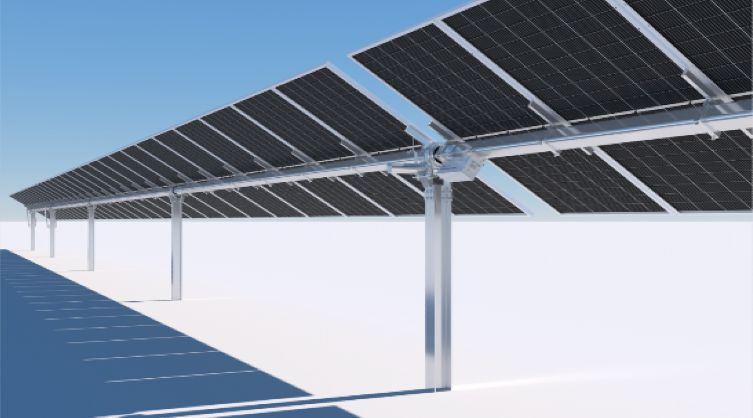Trina solar advances India’s green energy agenda with N-Type modules
By EPR Magazine Editorial October 5, 2023 1:17 pm IST
By EPR Magazine Editorial October 5, 2023 1:17 pm IST

Trina Solar’s N-Type Modules Lead India’s Green Energy Revolution with Cutting-Edge Technology and Innovation.
Trina Solar, a leading global provider of PV and smart energy solutions, has achieved Bureau of Indian Standards (BIS) certification for its latest n-type solar modules, the Vertex N NEG21C.20 and Vertex N NEG19RC.20. These cutting-edge modules will be showcased at the Renewable Energy India (REI) tradeshow in New Delhi.
Gaurav Mathur, Director of Trina Solar India, expressed his excitement, stating, “The introduction of our high-performance Vertex N modules in the Indian market, following BIS certification, aligns perfectly with India’s ambitious goal of reaching 500GW of renewable energy capacity by 2030.”
The Vertex N NEG21C.20 stands out with a remarkable 700W+ maximum power output and up to 22.5 percent efficiency, offering exceptional customer value, reliability, energy yield, and cost-effectiveness in terms of the levelised cost of energy (LCOE) and balance of system (BOS) expenses. Similarly, the Vertex N NEG19RC.20 delivers a commendable power output of 610W and efficiency of up to 22.6 percent. Notably, both modules employ larger-sized solar cells, measuring 210x210mm and 210x182mm respectively, generating more power compared to their predecessors with smaller cells.
A standout feature of these modules is the advanced i-TOPCon technology, or tunnel oxide passivated contact cell technology, significantly enhancing energy conversion efficiency. The ultra-thin tunnelling oxide layer captures previously unabsorbed light, increasing cell efficiency and allowing the module to harness more energy per unit area.
Moreover, these n-type modules are designed to optimize bifacial power generation performance, boasting a bifaciality factor of 80 percent ±5 percent. They also seamlessly integrate with TrinaTracker’s smart trackers, excelling in extreme weather conditions and challenging terrains, characteristics often encountered in India.
These modules incorporate other leading-edge technologies, such as multi-busbar (MBB) for improved light absorption and high-density packing to maximise surface area. Utilising non-destructive cutting technology, the cells have ultra-smooth edges, enhancing the module’s overall mechanical performance and resilience against external forces.
Gaurav Mathur emphasised, “The introduction of our new n-type modules in India underscores our commitment to providing state-of-the-art smart energy solutions to the Indian market.” He noted that a prominent trend in the global solar industry is the gradual replacement of p-type solar cell technology with n-type technology. Furthermore, he highlighted India as Trina Solar’s second largest market in the Asia Pacific region, following China, and underscored their dedication to meeting the market’s needs and expectations.
Trina Solar is at the forefront of commercialising n-type technology, with plans to ramp up production and make it a mainstream product. By year-end, Trina Solar is projected to reach a n-type wafer capacity of 50GW, module capacity of 95GW, and cell production capacity of 75GW, including 40GW of n-type cells.In addition to their product announcements, Trina Solar celebrated surpassing 9GW in cumulative shipments to India since their inception in 2010.
At the REI 2023 event, Trina Solar will also showcase its proven p-type technology modules, including the Vertex DEG21C.20, Vertex DE21, and Vertex DE19R. These bi-facial dual-glass modules leverage the latest 210 technology, offering power outputs of up to 665W and efficiencies reaching 21.4%. The high power and efficiency of these modules translate to fewer modules required to achieve a project’s total power output, resulting in reduced land requirements, trenching, cabling, and wiring expenses, ultimately lowering both the balance of system (BOS) cost and the levelised cost of energy (LCOE).
Additionally, Trina Solar will present its first-generation Vanguard 1P tracker, designed to be fully compatible with ultra-high-power modules ranging from 400W to 700W+. This tracker incorporates various innovations to streamline installation, reduce costs, and enhance performance, particularly in terms of terrain adaptability and power output optimisation.
Furthermore, TrinaTracker has expanded its vendor network in India, strengthening cost competitiveness and accelerating delivery times for structural components. Trackers are gaining popularity in India, especially in regions with abundant sunlight, as they enable bi-facial modules to capture more sunlight throughout the day.
Finally, Trina Solar will exhibit its vertically integrated Elementa Battery Energy Storage system at REI. The company’s commitment to offering fully integrated solutions, including modules, trackers, and energy storage systems, aligns well with India’s goal of achieving 500GW of renewable energy by 2030.
According to the International Renewable Energy Agency, India ranks as the third largest solar market in Asia, with 50GW of installed solar energy capacity as of the end of 2021, following China and Japan. India’s solar market is experiencing rapid growth, with substantial additions to both utility-scale and rooftop solar capacity. The market is projected to expand significantly, with approximately 14.2GW of new utility-scale projects and 2.8GW of rooftop or onsite solar projects expected to be commissioned in the 12 months ending March 2024, amounting to a substantial market size increase of US$273.82 billion.
We use cookies to personalize your experience. By continuing to visit this website you agree to our Terms & Conditions, Privacy Policy and Cookie Policy.